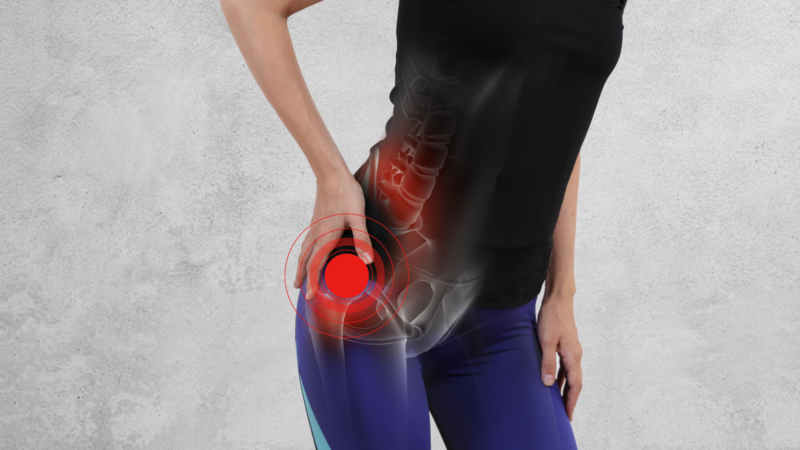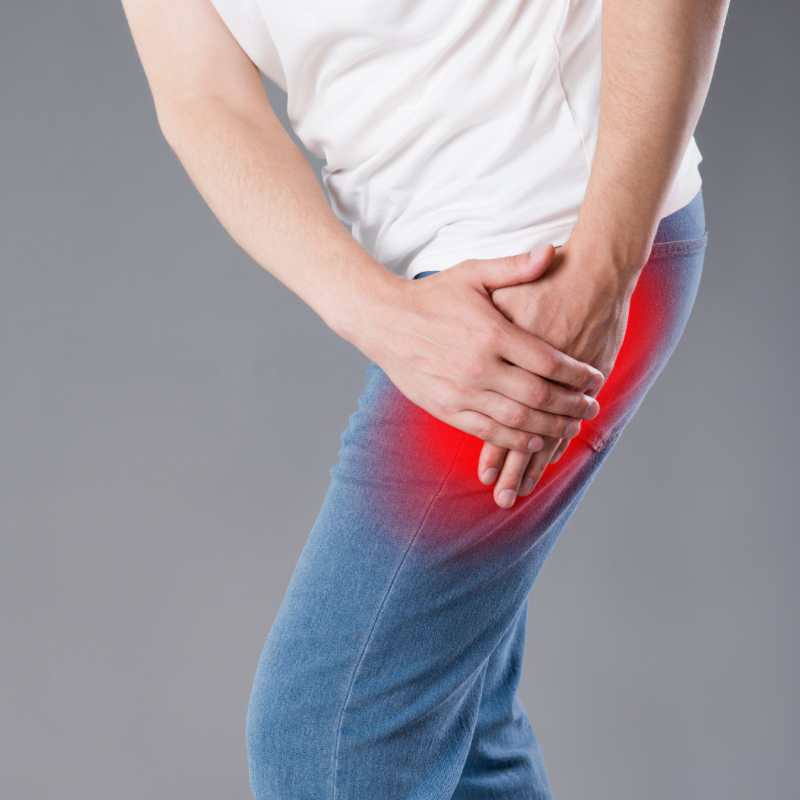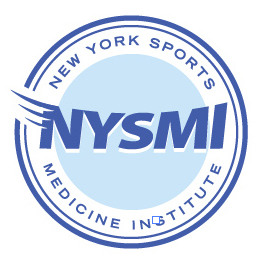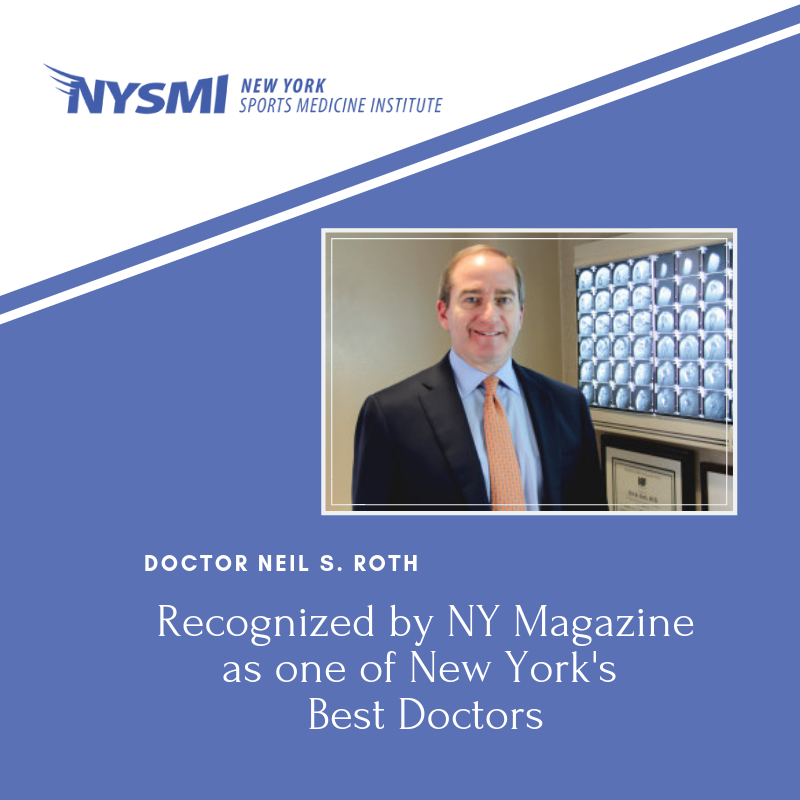
Hip Doctor NYC
New York Sports Medicine Institute | Orthopedics is committed to excellence by providing the highest quality of orthopedic and sports medicine care. If you’re looking for a top hip specialist New York patients trust, Dr. Neil S. Roth at New York Sports Medicine Institute is recognized among the best hip replacement surgeons in NYC. Our team offers advanced treatment for hip injuries and conditions, including both surgical and non-surgical options, making us a leading destination for NYC hip replacement care. Along with addressing immediate or chronic problems, NYSMI integrates prevention strategies into every treatment plan to help alleviate future difficulties. We serve patients ages 3 and up, providing expert care from a skilled hip doctor in NYC and a full team of orthopedic specialists to treat shoulder, knee, hip, and other joint issues — from mild discomfort to severe injuries.
Meet Our NYC Hip Doctor
What Conditions Can a NYC Hip Doctor Treat?
New York Sports Medicine Institute provides a wide range of highly specialized treatments to properly evaluate and treat sports-related and chronic conditions affecting the shoulder, knee, hip, elbow, hand, wrist, foot, and ankle. Sports injuries are often caused by trauma suffered during competition and repetitive or overuse wear and tear. Chronic conditions may include arthritis, age-related deterioration, or any number of factors related to use or associated health issues.
When surgery is required, NYSMI offers minimally invasive arthroscopic surgery for a number of conditions related to injury of the shoulder, knee, hip, elbow, foot, ankle, hand, and wrist. Our orthopedic surgeons are also highly regarded for providing hip, knee, and shoulder total joint replacement.
Physical therapy is frequently prescribed for the treatment of sports injuries and chronic injuries that may not require orthopedic surgery. Physical therapy is also prescribed to ensure optimal healing and training following some orthopedic surgery procedures. For a number of patients, conducting physical therapy at the New York Sports Medicine Institute provides convenience and comfort – a visit to one location serves multiple needs and provides comprehensive care to keep you in the game.
Click to learn more about specific services and ailments
What Does an Orthopedic Surgeon do?

Are you curious to know what a highly skilled orthopedic surgeon is able to do? Not only can an orthopedic surgeon treat various injuries and traumas with both surgical and non-surgical techniques, but some even specialize in certain areas of the body. As the founder of New York Sports Medicine Institute, Dr. Neil S. Roth is a highly acclaimed board-certified orthopedic surgeon who specializes in the area of comprehensive sports medicine, shoulder, elbow, and knee surgery.
NYSMI
He has been recognized by New York Magazine as one of New York’s best doctors and named among Castle Connolly’s top doctors in the New York Metro area. Among this elite group of medical professionals, Dr. Roth takes great pride in the recognition of his entire team’s exceptional skill and dedication. If you have been searching for a highly distinguished hip pain specialist NYC residents trust, or one of the best hip replacement surgeons in NYC, contact New York Sports Medicine Institute. Our team provides comprehensive care, including advanced NYC hip replacement procedures, sports medicine treatment, orthopedic surgery, concussion care, and physical therapy at both our Westchester and New York City locations. Whether you need a hip specialist New York patients rely on for complex cases or a hip doctor in NYC for personalized treatment, we encourage you to learn more about our specialties and how we can help you.
Orthopedic Concentrations
Orthopedic surgery can be used to help treat patients with a wide variety of injuries or other related traumas. Some of the most common conditions orthopedic surgery can help treat may include the following:
- Shoulder Injuries such as:
- Rotator cuff tears.
- Tendonitis and bursitis.
- Arthritis of the shoulder.
- Frozen shoulder.
- Shoulder instability.
- Fractures.
- General shoulder pain.
- Knee injuries such as:
- ACL, MCL, and PCL injuries.
- Meniscus Tear.
- Osteochondritis Dissecans (OCD) of the knee.
- Articular cartilage injury.
- Autologous chondrocyte implantation (ACI).
- Total and partial knee replacement.
- Arthritis of the knee.
- General knee pain.
- Elbow conditions such as:
- Tennis elbow.
- Ligament construction of the elbow.
- Elbow dislocation and instability.
- Osteochondritis of the elbow.
- Hip injuries such as:
- Fractures and tears.
- Hip impingement (FAI).
- Snapping Hip.
- Arthritis of the hip.
- Hip replacement.
- Foot & Ankle conditions such as:
- Sprains, strains, and fractures of the foot and ankle.
- Arthritis of the foot and ankle.
- Tendonitis of the foot and ankle.
- Hand & Wrist complications such as:
- Fractures of the wrist or fingers.
- Tendonitis of the wrist.
- Ganglion cysts.
- Arthritis of the hand and wrist.
- Carpal tunnel syndrome.
The Difference at New York Sports Medicine Institute
At NYSMI, our team is highly specialized in performing orthopedic surgery and treating the above-listed injuries and conditions. Through our expertise, we strive to help each and every one of our patients restore normal and pain-free function back to the affected area. If you have been searching for a skilled top hip doctor in NYC, contact us at New York Sports Medicine Institute. We want to provide you with the best care possible to get you back to feeling your best!
Orthopedic Surgeon Expertise
Since people tend to visit an orthopedic surgeon when their condition has gotten to a more severe or painful stage, orthopedic surgeons primarily focus on proper diagnosis and treatment for patients.
Diagnosis & Treatment
The various diagnostic tools orthopedic surgeons commonly use involve physical examinations, imaging studies, and lab tests. Treatment options can include both surgical and non-surgical procedures such as:
- Arthroscopic surgery – a surgical procedure using a tiny camera to see inside of a joint, used in different areas of the body.
- Open shoulder instability surgery.
- Rotator cuff surgery.
- Physical therapy treatment.
- Total or partial replacement of the shoulder, hip, or knee.
Depending on your particular injury or severity of your condition, different types of treatment plans may be recommended. It’s important to schedule an appointment with an orthopedic surgeon as soon as an injury takes place or a condition develops.
The Requirements
In order to become a board-certified orthopedic surgeon, there are several different accreditations you must first achieve. You must complete a four-year undergraduate program specifically comprised of one year of biology, one year of physics, and two years of chemistry. Then, followed by an additional four years of medical school and a post-graduate residency program. The residency program focuses solely on the specialty of orthopedic surgery. This allows prospective surgeons to get hands-on, practical exposure to the various surgical techniques and technologies used in this particular medical concentration. The founder of New York Sports Medicine Institute, Dr. Neil S. Roth, is both a board-certified orthopedic surgeon and sports medicine doctor.
NYSMI Can Help
He received his undergraduate degree from Duke University School of Medicine in Durham, North Carolina. He went on to complete his postgraduate studies and residency program at Columbia-Presbyterian Medical Center. Amongst the list of accreditations, Dr. Roth has also completed a fellowship in Sports Medicine at the world-renowned Kerlan-Jobe Orthopedic Clinic where he served as an assistant team physician for the Los Angeles Lakers, Dodgers, Kings and Angels, the Anaheim Ducks, and the University of Southern California. His high level of expertise and wide-set knowledge on the subject of sports medicine has set him apart as a skilled orthopedic surgeon.
Anatomy of the Hip

Hip Fractures and Tears
For athletes, hip pain often occurs as a result of making hard contact. A common injury among football players, for instance, is called a hip pointer – a blow to the pelvis that causes hip pain. When a hip pointer occurs, the bone just under the waistline can become bruised. In more severe cases, a fracture may occur.
Long-distance runners, basketball players and ballet dancers – all of whom jump on hard surfaces – may suffer stress fractures of the hip. Women, who typically lose more bone mass to osteoporosis, are more prone to hip fractures than men. And for women age 65 and up, a hip fracture is a highly serious matter. According to a 2011 study by the Archives of Internal Medicine, women above age 65 who fracture a hip have double the mortality rate within a year’s time as women without hip fractures.
The labrum, a ring of soft tissue around the rim of the hip joint, is responsible for keeping the femur (thighbone) in place. When overstressed, the labrum can become injured. The resulting labral tear is characterized by a “catching” sensation along with moderate pain. Hockey players, golfers, and soccer players – athletes participating in activities that involve fast pivoting around the hip – can be prone to labral tears.
Hip Conditions
The bones, tendons, and cartilage of the hip can all be subject to such medical conditions as tendonitis, bursitis, and arthritis. These conditions can lead to a breakdown of cartilage and an inflammation of the joint, causing hip pain and reduced range of motion. Age, physical conditioning, genetics, and diet can all contribute to conditions that cause inflammation.
Hip Impingement (FAI)
When the hip’s ball-and-socket joint experiences abnormal contact and damaging friction, this is a result of the condition known as hip impingement or femoroacetabular impingement (FAI). Oftentimes, the condition exists without being noticed until discomfort persists in advanced stages. Athletes will often agitate the condition sooner than non-athletes due to enhanced joint movement within the context of sports.
There are different types of hip impingement – cam impingement is that caused by deformity of the ball at the top of the femur (the thigh bone) and pincer impingement is the condition associated with a deformity of the socket. Combined impingement indicates that cam and pincer impingement are both presents. Hip impingement should be medically addressed since the results of wearing can lead to the onset of osteoarthritis.
Depending on the severity of hip impingement and other factors, non-surgical treatment options may include a modification of activities, physical therapy, and anti-inflammatory medication.
Snapping Hip
Snapping Hip is a condition that presents itself in a snapping sensation, sometimes accompanied by a popping sound, in the hip during various movements. Examples of these movements may include walking, running, moving the leg in a swinging motion, or even getting up from a chair. The sensation can range from a mild annoyance to a physical hindrance that affects athletic performance. The snapping may occur in a variety of areas where muscles and tendons move over bones within the hip.
The outside portion of the hip is the most common area of snapping the hip. It is where the iliotibial band passes over the protruding part of the femur known as the greater trochanter. Excessive snapping hip can be especially problematic, as it can lead to hip bursitis – the thickening and inflammation of the bursa sac. Other areas of the hip that may lead to snapping hip syndrome include the front of the hip and the back of the hip.
Additionally, damaged cartilage within the socket of the hip can become loose and cause the joint to catch, thereby creating a snapping hip that can become painful and debilitating. Physical therapy is a common non-surgical treatment for snapping the hip. In more severe cases that require surgery, minimally invasive arthroscopic hip surgery is often a viable solution. Treatment of snapping hip is entirely dependent on the particular circumstances of the individual case diagnosed.
Arthritis of the Hip
Arthritis of the hip is a condition that involves a loss of cartilage between the head of the femur (thighbone) and the socket area of the pelvis where the femur fits into the joint (the acetabulum). The absence of cartilage, which is sometimes the result of age-related wear and tear, causes the bones to rub against one another, leading to inflammation (swelling) in the area. The inflammation can become painful and affect the range of motion within the joint.
X-rays are often used to diagnose hip arthritis, as the loss of cartilage can be seen within the space between bones. Treatment for arthritis of the hip is dependent on a number of factors, including the severity of the condition and age of the patient. Treatment options include changing activities to reduce stress, using a cane to shift weight away from the affected joint, pain relief and/or anti-inflammatory medication, prescribed exercises, weight loss, and hip replacement surgery.
Hip Replacement
Hip replacement surgery has become a popular and highly successful option for the millions of Americans suffering from arthritis, including age-related osteoarthritis − the condition of cartilage worn away that results in bones rubbing against one another. Another degenerative hip disease that may require hip replacement is avascular necrosis of the hip, a condition where a loss of blood supply to the head of the femur (thighbone) causes the death of the bone tissue. Hip fractures and other hip conditions, including some that appear in childhood, can lead to the need for hip replacement surgery.
NYSMI Is Near You
Fortunately for patients, hip replacement surgery is often performed with minimally invasive surgery. The procedure involves two small incisions that allow the orthopedic surgeons to access the socket and femur without the need to cut the tendon and with minimal impact to soft tissue in the region. The ball and socket – the rounded head of the femur and receptacle area of the pelvis – are replaced with prosthetic devices. The minimally invasive procedure provides patients with significantly shorter time spent in hospital care and faster rehabilitation.
There are cases that due to their complexity of nature require traditional surgery for hip replacement. However, while traditional surgery requires longer hospital care and recuperation, like minimally invasive hip replacement surgery, outcomes are typically highly successful − enabling patients to move more freely without the pain experienced in the hip prior to hip replacement surgery.
Hip Injury Treatment
For patients of all ages and conditions, hip pain can spell the difference between normal activity and a less active lifestyle. Our board-certified orthopedic surgeons have successfully treated hundreds of patients with hip injuries. The physicians at the New York Sports Medicine Institute work with patients to explore options that include physical therapy and minimally invasive procedures, such as arthroscopic surgery, to address hip injuries. Regardless of the treatment required, our patient-focused practice will determine a treatment program designed to mitigate the effects of hip pain and strengthen the joint to protect it from future damage.
Common hip injury treatment includes:
- Evaluation and treatment of hip conditions, including tendonitis, bursitis, arthritis, labral tears, and sprains
- Evaluation and treatment of hip fractures
- Total joint replacement surgery of the hip
Recent Blog Posts From Our Hip Doctor NYC
HIP BURSITIS SYMPTOMS AND TREATMENT

If you may be suffering from hip bursitis, it is important to understand the condition and its symptoms to find the best method of treatment. Our experienced hip orthopedist New York City at New York Sports Medicine Institute is here to help you through your hip pain. Contact us today to learn what we can do for you.
What is Hip Bursitis?
Throughout the body, there are small sacs containing fluid that act as cushions for tendons, bones, and muscles around your joints. They help to reduce friction and are known as bursae. These bursae are located at many points of friction such as the heel, shoulder, elbow, knee, and hip.
When one or more of these bursa becomes inflamed, it is known as bursitis. There are two types of hip bursitis, trochanteric and iliopsoas (the latter being rarer). Trochanteric bursitis, the more common of the two, occurs when the bursa located at the bony part of the hip becomes inflamed. Iliopsoas bursitis occurs when the bursa on the inner side of the hip, near the groin, becomes inflamed. Our hip joint specialist NYC at NYSMI can help to treat hip bursitis, so you can live without pain. Contact one of our four offices to get the assistance you need.
Symptoms of Hip Bursitis
Trochanteric bursitis’s main symptom is pain occurring at the point of your hip. This pain can also extend to the outside of the thigh and will start as intense and sharp pain. Later on, the pain may turn into an ache that covers more of the hip. The pain is usually worse after periods of inactivity such as when sleeping while laying on the hip or sitting for a prolonged period. The hip area may also look red or swollen, and hurt more if you press on it. It is a good idea to see our hip pain treatment NYC at NYSMI if the pain becomes disabling, or you experience swelling, excessive redness, or a fever.
Diagnosis of Hip Bursitis
Hip bursitis is more common in women, as well as middle-aged or elderly people. There are certain risk factors associated with the development of hip bursitis, such as certain kinds of injury and pre-existing conditions. Some of these include:
- Previous hip injury
- Overuse injury
- Bone spurs
- Diabetes
- Rheumatoid arthritis
- Previous surgery
There are preventative measures you can take to lessen your risk of developing hip bursitis, but if you are already feeling pain, our hip care specialist NYC can help you.
When you visit our office, our specialists will perform a physical exam to locate tenderness in the hip. They may also perform other tests to rule out the possibility of another condition causing your pain.
Treatment of Hip Bursitis
On rare occasions, surgery may be necessary for the treatment of hip bursitis. However, non-surgical treatment, as offered by our best hip doctor NYC at NYSMI can prevent the need for surgery entirely in most cases. The first step to take is reducing the activities in your life that cause you the most pain, as well as doing some at-home exercises to reduce your pain. When feeling pain, you should use ice and make sure to give your hip adequate rest.
NYSMI of Manhattan
Sometimes pain pills can be prescribed to lessen the pain, although prolonged use of prescription drugs is usually not the preferred option. Pain pills should be used carefully and do not give you a long-term solution. The best and most natural option for the treatment of hip bursitis is physical therapy. Utilizing physical therapy as a treatment for your hip bursitis can be the answer you have been looking for to live a life free of debilitating pain.
How Our Hip Doctor NYC Can Help
New York Sports Medicine Institute is proud to offer you the highest quality, personalized treatment. Our expert therapists can give you exercises to improve your quality of life.
We are conveniently located at four offices in New York, White Plains, Paramus, and Union to give you the best care possible. You do not need to endure your hip pain without help any longer. You can contact us at our New York office with questions about how we can treat your hip bursitis at 212-861-2300, or visit our website to request an appointment today!
ORTHOPEDIC TREATMENT FOR HIP FLEXOR TEARS

Hip flexor tears are an extremely uncomfortable and painful situation. It can severely limit your range of motion and lead to other injuries. A hip flexor tear occurs when one of the many muscles in the iliopsoas and quadriceps tears and weakens the lower body. If you or someone you know is in need of a hip specialist NYC, our team at New York Sports Medicine Institute can help you!
Muscles included in the hip flexor are as follows:
- Psoas major: A deep muscle that connects your spine to your leg.
- Iliacus: A flat, triangular muscle that lies deep within your pelvis.
- Rectus femoris: One of the four quadricep muscles responsible for attaching your pelvis to the patellar tendon.
- Pectineus: Quadrangular muscle that lies on top of the inner thigh, it is the primary muscle in your groin.
- Sartorius: A long thin muscle that runs down the entire length of the thigh from the pelvis to the knee. It is responsible for flexing the knee and the leg.
The Importance of Healthy Hip Flexors
The purpose of the hip flexor muscles is to bring your knee toward your chest and to bend at the waist. Thankfully, there is a treatment for the tear and you can receive that treatment when you visit a NYC hip doctor. At the New York Sports Medicine Institute, you will receive care for any tear that you have suffered around the hip. We will also make recommendations in terms of physical therapy and nutrition.
Causes of Hip Flexor Tears
Common in athletes who jump or run while performing high knee are at greater risk for a tear. A hip flexor tear can occur from the following:
- Stress fractures from repetitive movements
- Physical activity such as force from playing a sport
- Fast pivoting, often associated with Hockey, golf, and soccer players.
Patients have often described the pain from a hip flexor tear as:
- Sudden pain
- Increased pain when lifting your thigh toward your chest
- Muscle spasms at your hip or thigh
- Swelling or bruising at your hip or thigh area
Grades of Hip Flexor Tears
Your tear is graded on a scale of 1-3. 1 is just a minor tear in which only a few fibers are damaged. 2, a significant number of muscle fibers were injured and you have experienced the loss of function in the hip flexor. 3, the muscle has been completely torn and results in someone usually not walking.
If you believe that you have suffered a hip flexor tear, we implore you to reach out to us today. Make sure to see a hip pain specialist NYC so that you can receive the care and early treatment you need.
Treatment of Hip Flexor Tears
Once your orthopedist decides on a course of action, whether that be surgery or physical therapy, you will begin both in-person and at-home treatment for the tear. Home remedies for lesser grade tears include the following:
- Application of an ice pack for 10-15 minutes.
- Switch the cold pack with a warm compress to loosen up muscle tightness.
- Take over the counter pain relievers such as Tylenol, ibuprofen, and Aleve(consult with your doctor first before taking).
- Rest and avoid activities that will stimulate your hip flexors for 10-14 days(longer if advised by the doctor).
Home exercises can help strengthen your hip flexor muscles and can help speed up the healing process. Here are some suggested exercises that can strengthen the flexor muscles:
- Seated Butterfly Stretch: Sit on the floor with back straight up, push feet together and pull the heels toward you. Hold for 30 seconds.
- Bridges: Lie on your back with knees bent and hands on the floor, then lift hips off the floor while squeezing the glutes. Breathe and hold for a few seconds, repeat 3 times.
- Lunges: From an upright position, take a step forward with your left foot, bend the extended knee, and transfer onto the front leg, lower yourself down until your knee is slightly above the floor. Repeat with the opposite leg.
There is a possibility of surgery if your flexor tear is severe enough. If that is the case, then your prescribing orthopedist will recommend you to a physical therapist to help build up strength back into the hips.
Contact our Hip Doctor NYC Today!
Be aware of your body and reach out to a top hip doctor in NYC to receive the best treatment for a hip flexor tear. At New York Sports Medicine Institute, our experienced team — including some of the best hip replacement surgeons in NYC — provides expert care for a wide range of hip conditions. Whether you require non-surgical treatment or an advanced NYC hip replacement procedure, our hip specialist New York patients trust is here to help you recover and return to full mobility. Contact us today to schedule an appointment and learn how we can provide the personalized care you need.
RECOVERING FROM HIP REPLACEMENT SURGERY

Hip replacement surgery is a procedure in which an orthopedist surgically removes a defective hip joint that has developed arthritis and replaces it with an artificial hip joint which is made of either metal or plastic. Hip replacement surgery is a last-resort option when all other non-invasive options such as physical therapy, pain management, and self-care have not worked. Once the hip joint has healed, patients report increased quality of life. At New York Sports Medicine Institute we are a team of orthopedists, physical therapists, a concussion specialist, and a hip orthopedist New York City and White Plains that can help you every step of the way of your hip replacement process.
Recovery After a Hip Operation:
Immediately after your hip replacement, you will be monitored by your team of doctors for several hours and either provided further treatment or released based on progress. You could feel some pain however we will provide you with medicine to reduce this. Anesthesia can cause breathing issues, which can cause mucus to accumulate in the lungs. Deep breathing and frequent coughing help to keep the lungs clean.
The typical post-hip replacement surgery hospitalization lasts one night, with some patients leaving the same day of surgery and others leaving days after.
Physical Therapy & Pain Management:
Regular exercise to restore strength and flexibility in the hip joint is essential for a complete recovery. The goal is to help you return to your daily activities. After you are released, you will need to begin outpatient rehabilitation. This begins based on your overall bodily condition post-surgery. At New York Sports Medicine Institute, our team of orthopedists, physical therapists, and a hip joint specialist NYC will work to get you back to living your life pain-free.
Depending on your hip condition, a physiatrist may offer injections that can reduce pain and aid in overall healing. In conjunction with physical therapy, your hip joint specialist NYC can greatly help you during the post-surgical rehabilitation process.
Take Care of Your Surgical Wound:
You can typically remove the surgical bandage after five days. If you have sutures or pins, keep the area clean and dry until it is removed about two weeks after surgery. When bathing you must protect the area so that you do not get wet. Your surgical team will go over this process with you.
If there are signs of infection, contact your hip pain treatment NYC immediately. Signs of infection may include:
- Redness around the cut.
- Drainage issues at the incision.
- Flu-like symptoms.
How To Reduce Swelling and Inflammation:
Circulation of the affected leg is slow after surgery, resulting in swelling of the calf and ankle. The swelling lasts on average 12 weeks but should decrease with each week. To reduce puffiness, we recommend resting your legs, knees above the heart, four to five times a day for 15 to 20 minutes each. Apply a cold compress to each painful or swollen area four to five times a day for at least 15-20 minutes.
Your physical therapist and physiatrist will help to reduce swelling and inflammation by prescribing the right treatment plan.
How To Prevent Blood Clots:
Physical activity is the key to reducing the risk of a serious blood clot in your body. Walking, even over short distances, promotes circulation so as soon as you receive the go-ahead to begin walking, you should. Aim and bend your ankle repeatedly while sitting. Also, remember to take a prescription anticoagulant medication.
The Symptoms of a Blood Clot Include:
- Increase swelling of the affected leg, which does not decrease.
- Pain when touching the calf.
If you have any of these symptoms, contact our office immediately for further instructions!
Follow-Up Post Hip Replacement Surgery:
Up to one-year post-surgery, you will have regular follow-up visits with your orthopedic surgeon. Your physician may run tests including x-rays, perform a physical examination, and discuss your concerns and mobility and comfort progress. Because we are a multidisciplinary team of orthopedists, concussion specialists, physical therapists, and a hip care specialist NYC, we can help you in all aspects of the hip replacement process.
Contact Our Hip Doctor NYC
If you or someone you know has recently undergone hip replacement surgery, New York Sports Medicine Institute can help get them on track to recovery. Our team offers exceptional one-on-one treatment that can help give you the attention you deserve. For questions on how we can help, schedule an appointment today!
WHAT ARE MY TREATMENT OPTIONS FOLLOWING HIP DISLOCATION?

In need of the best hip doctor NYC to help treat your pain following a dislocation? Dr. Neil Roth at NYSMI is here to help you. Contact us today and continue reading to find out more.
What is a Hip Dislocation?
The hip is the largest weight-bearing joint in the body. Powerful muscles such as the glutes, quads, and hamstrings all connect to the hips. It allows us to be active with movements such as running, climbing, and jumping. This joint is crucial in many pursuits whether it be playing sports or getting through everyday activities. However, unfortunate incidents may occur where the hip can become dislocated.
NYSMI
Hip dislocations are most often the result of motor vehicle crashes. It can lead to serious, lifelong complications if not treated as soon as possible which is why it is critical to get treatment if you end up with a hip dislocation. By seeing a hip specialist NYC like one at New York Sports Medicine Institute, we can properly diagnose any hip pain to see if it may be due to hip dislocation and provide you with the proper treatment for recovery. NYSMI has three convenient locations in New York City, White Plains, and Paramus, and our team is eager to help you so that you can feel your best.
Symptoms of a Hip Dislocation
Experiencing hip pain can be a sign of many different conditions and it is important to speak to a NYC hip doctor to understand the root of the issue. Some of the most common signs of hip dislocation include but are not limited to:
- Abnormality walking
- Muscle Spasms
- Numbness or weakness on the side of the hip dislocation
- Visible deformity of the leg. When a deformity occurs it is often the knee and foot pointing towards the midline of the body, but can be seen in other ways.
A hip dislocation often happens simultaneously with high-force trauma and life-threatening injuries. Although not always this severe, it’s important to look out for these signs and find medical care immediately if any of these symptoms are present in conjunction with a hip dislocation:
- Trouble breathing
- Loss of Consciousness
- Clear traumatic injuries
Diagnosing the Issue
If you are experiencing any of the symptoms listed above, seeing a hip pain specialist NYC. It’s necessary so that they can assess the issue. One thing they may do is a physical examination where they can observe any possible abnormalities or atypical positioning in the hip. They may also conduct an X-Ray, MRI, and/or CT scan to see imaging of the hip to get a clearer look or confirm their diagnosis.
Treatments Options for a Hip Dislocation
Depending on the severity of the hip dislocation, different treatment options will be best suited for different cases. In a simple hip dislocation without any broken bones or further injuries. An orthopedist can usually push the ball back in by hand while the patient is under anesthesia. In a more serious case such as when the socket, femur, or pelvis as some examples is broken, surgery will be done to either repair the broken bones or replace the natural hip with an artificial one. No matter what treatment is done, physical therapy is usually a required and important part of the recovery process to help regain strength and improve the range of motion in the hip and the muscles surrounding it.
Here at NYSMI, we offer several services to help you recover swiftly and effectively. A member of our team will be able to create a customized treatment plan for your condition.
Contact A Hip Doctor NYC
If you or someone you know is looking for a hip joint specialist after a hip dislocation, look no further than New York Sports Medicine Institute. We understand that dealing with hip dislocation can be uncomfortable and even worrisome, but our team of professionals is here to help you feel comfortable and are here to assure you that you will get the best treatment you need. Visit our website for more information about what we do or to request an appointment today. We look forward to hearing from you!
WHAT CAUSES EXCRUCIATING HIP PAIN?

NYSMI – Hip Doctor NYC
Have you ever found yourself with excruciating hip pain? If yes, then the top hip doctor in NYC will suggest going to NYSMI to help you get the best treatment for your pain. At NYSMI we are dedicated to getting you back on your feet and back to the things that you love the most. We understand that being in pain is not an option for you and we want to make sure that is the case. Our team is always ready to help our clients in any way possible.
What Causes Hip Pain?
When it comes to hip pain there can be several different reasons why we might develop excruciating pain in our hips. For anyone who has ever had hip pain, they can tell you that it is nothing to mess around with. Hip pain can come from several different kinds of things. One of the most common reasons for hip pain is injuries that have happened in the past. Other causes of hip pain include:
- Inflamed tendons
- Any kind of Arthritis
- Trochanteric bursitis
- Hip fractures
- Pinched nerve
What are the Symptoms?
When it comes to the symptoms of hip pain there are several different ways to tell what kind of him pain you have besides the obvious one of being in pain. If you were to get up from a chair or just simply walking and you have a snapping sound or feeling in your hip this could be another symptom of hip pain. You might not have pain originally but it could mean that you might have pain later on down the road. This kind of sound usually comes from athletes or dancers. If you are having pain with the snapping it is usually a sign of cartilage tear or fragments of material in the hip. Other causes of hip pain include pain in the:
- Thigh
- Inside of the hip joint
- Buttocks
- Outside the hip joint
- Groin
Treatments
For anyone who has experienced hip pain, they will pretty much do anything to get relief for it. Good thing is that there is a way to relieve pain but you just have to be willing to put in the work to help get relief. Depending on what the cause of the pain is you might be able to just get some over the counter medicine that will temporally relieve the pain but it is not the solution. If you seek medical advice from a doctor in New York City they might suggest going to a physical therapist. If the pain is from exercising then the doctor or physical therapist might suggest taking a break for a couple of days to see if the pain subsided. Usually, this is the case from pain is from exercising.
What Can a Physical Therapist Do for Hip Pain?
A physical therapist is highly trained and a licensed professional. In a wide variety of areas of the body to help people who are suffering from acute and chronic pain. Their goal is to decrease your pain while also increasing your mobility. If you are suffering from walking, going up and downstairs, sitting in a chair, or running a physical therapist can help with those problems. If a doctor recommends you to see a physical therapist the therapist will asses several different things to see where your strength, range of motion, and balance are.
NYSMI
If you do happen to need surgery going to physical therapy will still be a great option. They will make sure that you are ready for the surgery. They help by building up the muscles around the joint so that after the surgery you have muscle there to help you do some of the beginning exercises. If you are looking to get relief for your pain going to a physical therapist is a good place to start.
Contact Our Hip Doctor NYC
If you are someone you know is looking for a hip orthopedist New York City and they are looking for relief from their hip pain then tell them to check us out. Our team wants to help you in any way that we can. We understand that that hip pain is something that no one should have to suffer through and that is why we want to assist you. Please visit our website to schedule an appointment. We look forward to hearing from you.
210 E 64th St 4th Floor, New York, NY 10021
New York
New York Sports Medicine Institute
210 East 64th Street, 4th Floor
New York, NY 10021
Tel: 212-861-2300 – Fax: 914-920-2085
New York Office Hours:
Monday – Friday: 7:30 am – 5:00 pm
Late hours by special appointment only.
NOTE: Hours may change due to surgical schedule. We do our best to communicate these changes and accommodate your needs. We encourage our patients to call our offices with any issues or requests. Emails should be used for informational purposes; we will be glad to review and respond during regular office hours.







